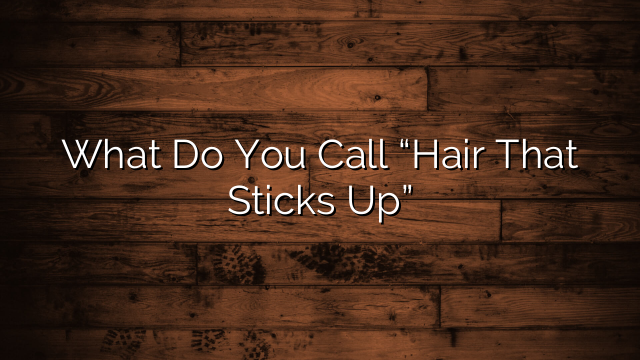In the vast landscape of human appearance, hair often serves as a distinctive feature that can both shape and reflect one’s identity.
While some may possess sleek tresses that gracefully cascade down their shoulders, others grapple with an intriguing phenomenon known as ‘hair that sticks up.’ This enigmatic occurrence has captured the attention of many, prompting questions about its nature and nomenclature.
Often associated with disheveled mornings or impervious to combing efforts, this rebellious type of hair has been bestowed with a variety of names. From the whimsical allure of bedhead to the persistent defiance of cowlicks, these terms attempt to capture the essence of such unruly strands.
Additional descriptors include flyaways – those small strands that seem to have escaped gravity’s clutches – static hair, which stands erect due to electrical charges, and frizz—a manifestation of untamed texture.
Within this article, we shall delve into each term in order to unravel their meanings and explore the scientific underpinnings behind these peculiar hairstyles. By shedding light on ‘hair that sticks up,’ we hope to foster a deeper understanding and appreciation for the intricate world woven upon our heads.
Key Takeaways
- Different names for hair that sticks up include bedhead, cowlicks, flyaways, and static hair.
- Bedhead refers to disheveled hair in the morning, and morning hair routines are required to tame it.
- Cowlicks are tufts of hair that defy gravity and form distinctive patterns. Styling techniques and products can manage cowlicks.
- Flyaways are unruly strands of hair that stand up or stick out, and they can be more prominent in humid weather. Anti-frizz products and gentle combing can tame flyaways.
Bedhead
Bedhead refers to the disheveled and tousled appearance of one’s hair upon waking up, characterized by strands that stick up in various directions. It is a common phenomenon experienced by many individuals due to the natural movement and friction that occurs during sleep.
Morning hair routines are often required to tame bedhead and achieve a more polished look. These routines may involve brushing or combing the hair, using styling products such as gels or mousses, or even resorting to hairstyles specifically designed for short bedhead hair.
Styling options for short bedhead hair include sleek slicked-back styles, textured pixie cuts, or messy buns. By experimenting with different techniques and products, individuals can find a hairstyle that suits their personal preference while effectively managing their bedhead situation.
Cowlick
Resistant to being tamed, the unruly tuft of hair that defies gravity and forms a distinctive pattern is commonly known as a cowlick. Cowlicks are often found at the crown or front hairline and can be quite challenging to manage.
To style hair with a cowlick, various techniques can be employed. One approach is to use a blow dryer and brush to direct the hair in the desired direction while applying heat. Additionally, using pomades or waxes can help provide hold and control for cowlicks, allowing for more manageable styling options. These products work by weighing down the stubborn strands and providing structure to maintain the desired hairstyle throughout the day.
It is crucial to choose suitable products specifically designed for cowlicks to achieve optimal results without causing further damage or complications.
By employing effective hair styling techniques and utilizing appropriate products, individuals can effectively manage their cowlicks and achieve desirable hairstyles despite their rebellious nature.
Flyaways
Unruly strands of hair that seem to have a mind of their own, flyaways can create a sense of frustration and annoyance for those seeking a polished and sleek hairstyle.
Flyaways are those small sections of hair that stand up or stick out from the rest, giving an unkempt appearance. In humid weather, flyaways tend to be more prominent as the moisture in the air causes the hair to become frizzy and unruly.
To tame flyaways in humid weather, it is essential to use anti-frizz products like serums or sprays that provide control and hold. Additionally, using a wide-tooth comb instead of brushing vigorously can help smooth down the flyaways without causing further damage or breakage.
Alternatively, some hairstyles embrace and accentuate flyaways rather than trying to eliminate them completely. Messy buns, textured braids, or loose waves can all incorporate flyaways into the overall look for a more effortless and natural appearance. Embracing flyaways allows for versatility in styling while still maintaining an elegant aesthetic.
Static hair
Static hair can be a persistent annoyance, with strands seemingly magnetized and unwilling to conform to the desired style. It occurs when hair becomes charged with static electricity due to various factors such as dry air, friction, or synthetic materials. Understanding the science behind static hair is crucial in order to effectively manage it.
One way to prevent static hair is by using a humidifier in rooms with low humidity levels. Additionally, incorporating conditioning treatments into your haircare routine can help reduce static electricity buildup. Styling tips for managing static hair include using anti-static sprays or serums, avoiding plastic brushes that generate more friction, and opting for natural fiber materials like silk or cotton when styling or sleeping.
By following these preventive measures and employing proper styling techniques, one can successfully combat the frustrations caused by static hair.
Frizz
Frizz is the result of hair strands becoming raised and separated, creating a halo-like effect around the head. Several factors can lead to frizzy hair, including humidity, damage from heat styling tools or chemical treatments, lack of moisture, and genetics.
When the hair cuticle becomes rough or damaged, it allows moisture to enter and swell the hair shaft, resulting in frizz. To manage frizz, one should focus on maintaining adequate moisture levels in the hair by using hydrating shampoos and conditioners and avoiding overwashing.
Additionally, using serums or oils can help smooth down the cuticle and reduce frizz. Styling techniques such as blow-drying with a diffuser or using straightening irons can also be employed to achieve a sleek look for frizzy hair.
Frequently Asked Questions
What causes bedhead and how can it be prevented?
Bedhead is caused by friction between the hair and pillowcase, leading to static electricity and flattened strands. To prevent bedhead, use a silk or satin pillowcase, avoid brushing before bed, and opt for loose hairstyles like braids or buns to maintain hair volume.
Are certain hair types more prone to cowlicks?
Hair texture and styling techniques can contribute to the occurrence of cowlicks. Certain hair types, such as thick or coarse hair, are more prone to cowlicks due to their natural tendency to resist being styled in a specific direction.
How can I tame flyaways and keep them under control?
To tame flyaways and prevent bedhead, it is important to establish a proper hair care routine. This includes using smoothing products like serums or hairsprays, avoiding excessive heat styling, and protecting the hair while sleeping with a silk or satin pillowcase.
Why does hair become static and how can it be minimized?
Static hair is caused by a build-up of electric charge, resulting in strands repelling each other. To minimize static hair, one can use hydrating products, avoid excessive heat and friction, and opt for natural fiber materials.
What are the main causes of frizzy hair and how can it be managed effectively?
Frizzy hair is commonly caused by humidity, heat damage, and lack of moisture. Effective management involves using sulfate-free shampoos, hydrating conditioners, and anti-frizz serums. Preventing bedhead requires sleeping on silk pillowcases and tying hair in a loose bun or braid.
Conclusion
In the realm of hair aesthetics, there exist various terms to describe the phenomenon of upwardly protruding strands.
Bedhead refers to a disheveled appearance caused by one’s nocturnal slumber.
A cowlick denotes an unruly tuft of hair that defies the normal direction of growth.
Flyaways represent those stubborn, stray strands that refuse to be tamed or controlled.
Static hair refers to the electrified state of follicles, standing on end due to electrical charges.
Lastly, frizz characterizes the untamed and wild nature of unmanageable hair.
In summation, these terms encapsulate the diverse manifestations of upright hair formations that can confound even the most seasoned stylists.
Thus, when endeavoring to comprehend and communicate about ‘hair that sticks up,’ one must navigate through a lexicon rich in descriptive terminology such as bedhead, cowlicks, flyaways, static hair, and frizz; each term capturing unique aspects of this enigmatic phenomenon.
As we delve into this complex topic with knowledgeable precision and creative flair, we unravel a tapestry interwoven with strands defying gravity – an arresting sight reminiscent of Medusa’s serpentine locks cascading towards an uncertain fate.



